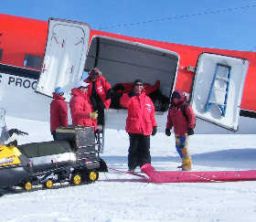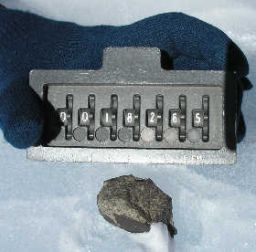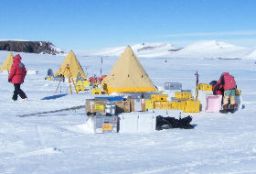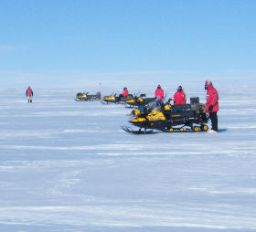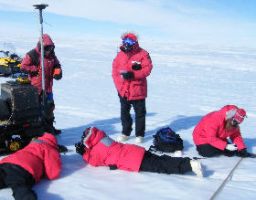ANSMET team • Dec 29, 2008
The Antarctic search for meteorites: put-in at last; week of productive searches
December 23-29, 2008
The gang's all here!
December 23, 2008
Yesterday, the Basler made two trips to our campsite bringing gear. The last flight included the solar panels, storage batteries and converters that allow us to recharge all of our battery-operated equipment. This morning, John and I sorted out the pile of gear, and set up the electrical system. Most of the afternoon was spent recharging satellite phones, the laptop I am typing on, and personal equipment. And then…
Finally, they made it! About 14:45 (2:45 PM) today the Basler landed with the rest of our field gear and the remaining four members of the ANSMET team. After thirteen days out here on our own, John and I were not quite sure what to make of these strangers in red parkas. We finally decided to let them stay, and even helped them set up their tents. As a welcome gift, I gave each of them half a bucket of ice so that they could make water.
After they settled in and had supper, everyone gathered in Jani’s and Amy’s tent for a confab. John talked a bit about where we are, where we will be searching for meteorites, and other expedition items. And of course, we just talked and joked some. The next couple of days will be light days as we organize ourselves and equipment for meteorite hunting, and to give the four new arrivals time to adjust to the altitude. Our camp is at an elevation of about 2,550 meters (about 8,400 feet), and the new arrivals just came from sea level.
Tomorrow, the real hunt begins. Let there be many meteorites, and big ones.
And now I have a mea culpa. I had been advertising Shackleton’s attempt at the South Pole as taking place in 1907. Silly me. He left England in 1907, but wintered over on Ross Island (where McMurdo Station is located), and made his drive to the Pole in 1908. So…
100 years ago this date: Shackleton’s party find that they are not all the way up on the plateau after all, and spent a day climbing and covering a region with many hidden crevasses. They constantly fall into crevasses, and are only saved from death because they are harnessed to their sledges. In spite of this, they make 13 miles, and end at 85 degrees, 41 minutes south latitude.
Cheers,
LYAN
duck
On to the Chore at Hand
December 24, 2008
Today we finally got out and started the serious, systematic search for meteorites.
In the morning, we first did a few camp chores. Once done everything was ready for the start of our real work. Well, almost everything. We have two newbies on the team, people who have never hunted for meteorites on the ice. So before we threw them into the game, we gave them a short tutorial on how to tell the good rocks from the bad.
John and I had previously flagged a number of meteorites near camp. They are scattered in amongst many, many Earth rocks. After camp chores were done, everybody went out to have a look at the variety of rocks in the area, and to compare them with bona fide meteorites. While we were doing this, one more meteorite was found near camp! Obviously, the lessons were learned well.
After lunch we set out and searched an ice field northwest of camp. This is an easy “first search” area because the ice is almost totally free of Earth rocks. We spent the afternoon systematically ski-dooing down wind, shifting over, and then ski-dooing back upwind in a line of six ski-doos, every person scanning a “lane” of ice roughly five meters (about five yards) on either side. Any rocks that were spotted were inspected closely to see if they were meteorites. The result, we turned up three meteorites. For a first afternoon, it was an auspicious start. As the team gets better at coordinating our efforts and more expert at filtering out the Earth rocks from meteorites, the pace of discovery will likely increase.
100 years ago this date: Shackleton’s team made good progress; just over 11 miles. Sitting in their tent on Christmas eve, thoughts turned toward the sights and sounds of their homes and friends in Britain.
We can empathize with those hearty explorers.
Cheers,
LYAN
duck
A Little Work, a Little Play for the Holiday
December 25, 2008
Today started out warm, -11 C (about 13 F) and sunny, but there were clouds to the south and east. As it was Christmas, we decided to end work a bit early and get together for a communal supper. The day’s plan: return to searching the ice field we had started yesterday. With luck, we could finish it off and declare it “done.”
The searching went well at the beginning. We were clearing ice, and finding a few meteorites. However, after a short lunch break, those clouds began to move in our direction, and pretty soon the sun was just a dim light bulb in the sky. Slightly cloudy skies actually make it easier to spot rocks on the ice surface. All the ice and snow begin to merge into a uniform light background, and the dark rocks really stand out. But when it gets as overcast as it was this afternoon, we can no longer see surface features, such as sastrugi (hard, wind sculpted snow drifts). This can lead to accidents, either on foot or on ski-doo.
For team safety, we called it an early day and went back to camp in mid afternoon.
In the evening, we all gathered in Amy’s and Jani’s tent for our holiday pot luck supper and to exchange gifts. Oh, and have a long round of gabbing. The Christmas gift exchange is a long-standing ANSMET tradition, and it really helps cement the team together.
We also received gifts sent by friends and relatives, and from Ralph, the ANSMET leader. We thank all of you -- the gifts are much appreciated, and we had a good laugh over some of them.
100 years ago this date: Shackleton’s team had a hard cold day. They continued man-hauling heavy sledges up slope, but in the face of strong winds from the south with temperatures of -27 C (-16 F). They are still about 475 kilometers (295 miles) from the Pole, and have decided they must reduce their rations if they are to have enough food to get to the Pole and back.
Cheers,
LYAN
duck
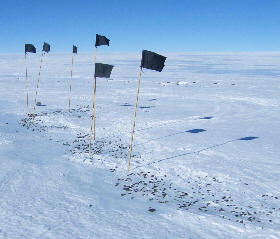
Six Flags
Six flags mark the locations of meteorites amongst all those Earth rocks.ANSMET
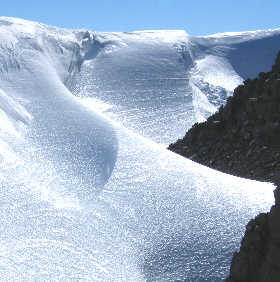
Wind scoop on the side of Davis Nunatak.
ANSMET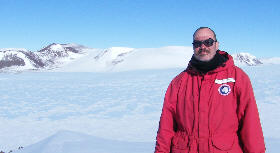
Duck
With Mt. Ward in the background.ANSMET
A Good Haul
December 26, 2008
Today was a good day on the ice. We started out going to some small patches of ice downwind of a moraine east of camp. (A moraine is a concentration of rock entrained in a glacier.) These small ice patches are just full of rocks. John and I had looked into a couple of these patches way back on 15 December before the rest of the crew arrived. Within a few minutes we had found three meteorites in two ice patches. We marked them with the intent of bringing the full team out to have a look.
John got to one of the ice patches first and removed our markers. When the rest got out there, John asked them to find the meteorites. After a few minutes, the team had found the two John and I had marked in that ice patch, and went on to find four more! From there we went on to other ice patches and the moraine. We were rewarded with many more meteorite finds.
Ultimately, we called a halt to the moraine search, and began a systematic search of the ice field northeast of camp. Here again we met with success. So much so that we ran out of flags to mark the locations where we had collected. The haul for the day: 34, including one that appears somewhat unusual. The team is really hitting its stride.
As long as we had a little extra time, we took a scenic route back to camp, ski-dooing along a giant wind scoop along the west side of one of the Davis Nunataks, and up on top of the nunatak for a grand view of Mount Ward. (A nunatak is a hill that rises through a glacier.)
All in all, a very satisfying day.
100 years ago this date: Shackleton’s team made good headway, just over 14 miles. This in spite of soft snow, which sticks to the sledge runners making it harder to pull, stiff cold winds from the south, and the ever-present climb. Although they are on the polar plateau, the terrain still rises toward the Pole.
Cheers,
LYAN
duck
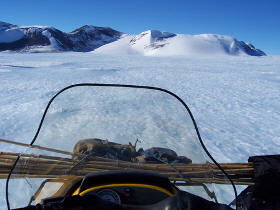
Mt. Ward through my windshield
ANSMET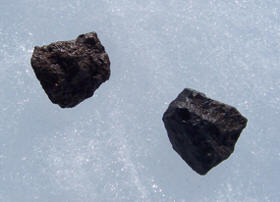
Which is the meteor-'right'?
ANSMET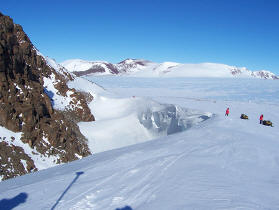
The windscoop
ANSMETSearching, Systematics, and Skidooing
December 27, 2008
What better Christmas present could we ask for than amazing weather for meteorite hunting? It has been a balmy 10 degrees F and almost no wind all day today and much of yesterday. The wind really makes a huge difference; we all put our hats and coats back on when we reached the windy, downslope portion of the big ice field we are now systematically searching. It is hard to focus on our searching tasks when the views we have from this ice field are so amazing. We can see Mount Ward ahead of us to the southeast, Otway Massif to the east, the Dominion Range to the north, usually bathed in orange sunlight, and the dark cliffs of the Davis nunataks, made of Ferrar Dolerite (more on this from Amy in a later post!), and camp to the northwest.
Don't worry though -- we have paid attention enough to find 29 meteorites today and 34 yesterday! We are so pleased we've had such good work days just as we've arrived in the field (us four late-comers, at least). A couple have been quite big, the size of a mini-bread loaf, and others have been unusual, perhaps carbonaceous, from the outer portion of the asteroid belt. We'll have to see what the crew at Johnson Space Center has to say about them. Much of our other searching has been in small moraines, where most of the rocks are from the surrounding mountains or the base of the glacier. It can be challenging to put together the little catalogue in your mind of meteor-"rights" and meteor-"wrongs". But we think we're getting better, and may be nearly ready for the big moraines, which have a much broader library.
At day's end yesterday Johnny rewarded us with a little sightseeing skidoo ride up onto one of the nunataks. We had amazing views of a giant windscoop, did some fun skidooing up snowy slopes, and got views to many tens of miles across the Mill and Beardmore glaciers we've been reading about from the adventures of Shackleton and Scott.
Huge thanks for the Christmas wishes via Iridium text from Ralph, Barbara, Catherine, Joe, Lee, and Nick. We hope it was a merry one for you too!
100 years ago this date: Shackleton’s team continued to climb rises on the plateau, man-hauling the sledge with 150 pounds of gear and supplies. They made just over 14 miles and have reached 9,800 feet elevation. They had a calm day, as did we. A day in Antarctica without wind is a blessing.
- Jani
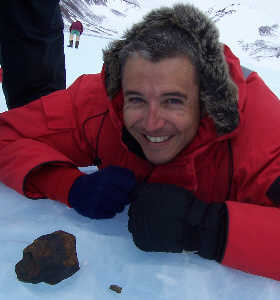
Deon
ANSMET Next to a big meteorite we found today.
Jani
Jani Radebaugh next to the newly conquered Mount Radebaugh.ANSMET
The Experience of Nothingness:
December 28, 2008
Deon here…
Ha! Lured you in with the title. of the post. Not a reflection of my Antarctic experience, but rather along the lines of a book title that a friend wanted me to bring down. I chickened out of this, no doubt, introspective reading experience, fearing that I might become the victim of depression. I have my skidoo for that now, and the lack of bedtime hugs and kisses (don't worry, it's tongue-in-cheek depression). I could ask my tent mate for help, but Joe and I are at the same institution and still need to look each other in the eye when we get back! Fortunately Joe has an incredible sense of humor and is a good tent mate.
Our skidoos are acting up now and again. Mine has given more trouble than the others, and I suspect it is because they are tuned for the elevation at McMurdo. There have been several occasions where it died in the field. Fortunately John sorted it out eventually, by taking apart the carburetor. Thankfully the wind wasn’t blowing at the time!
Our days have been productive in terms of finding meteorites, and today we found a couple of achondrites, one of them quite unusual! We started today off with thick fog blotting out the surrounding mountains, but eventually went out to our current search area, only to be turned back after a few hours by bad light. When the contrast goes flat here, you cannot even see the topography on the ice - everything looks flat, which makes for many unexpected bumps during a snowmobile ride back to camp (actually I like it! It's a lot of fun!)
The preceding days have been much better weather than when we climbed out of the aircraft. It was incredibly windy (which means cold) the first night, but I woke up yesterday to unfrozen strawberry jam next to my head...always a good sign!
I'm still feeling the tiring effects of altitude, and usually start off the morning out of breath (which gets forgotten once we find the first meteorite for the day), and then by lunch my fingers start needing hand warmers and a different set of gloves. Speaking of which, Ralph, thanks for the mitts! They kick tush.
We typically start the day off with a weather check, and get out into the field by 9am, followed by work, a 10-minute lunch, work, and then head home at 5pm-ish. My personal routine involves waking up, having hot chocolate and bread/oatmeal for breakfast, dressing in my extreme weather gear, boiling water and filling a flask for the road, and making sure I have enough chocolate for snacking on out in the cold. If there's time, I will massage healing balm into my cracked fingers. After work we refuel the skidoos, pack away the meteorites, chip out ice for making water, get the stove started to melt the ice and heat up the tent, undress the extreme weather gear and hang up shoes and socks to defrost, get dressed into more comfortable warm clothes, drink something hot, and then collapse exhausted for a 15 minute nap. This is followed by cooking dinner, hanging up food to defrost for the next day (with the stoves going, the top of the tent is warm enough to defrost things while the floor is freezing), cleaning dishes (no soap!), and meeting for a short social gathering and bedtime reading by John. I generally wake up at 3am because there is a spot in my sleeping bag that has let in freezing cold air, so I readjust to block out the light and the cold, and return to snooze land.
I got to change my socks and underwear today, had a shave, washed my hair -- a mighty achievement by ANSMET standards I think! Despite the hardship of living out here, for the moment we are comfortable enough to enjoy the beautiful surroundings we find ourselves in and we are all in good spirits, each day hopeful that we will catch several big fishes from neighbors in the solar system.
Finally, many thanks to friends and family, and Lucy, who sent us gifts to lift our spirits over Christmas! There are many people who I miss tonight, but I take heart in the adventure and the friends I am surround by here on the ice!
D.
P.S. For those wishing to find us on google Earth, our coordinates are 85 degrees, 38 minutes, 15 seconds south; 166 degrees, 39 minutes, 18 seconds east.
100 years ago this date: Shackleton's party pulled their sledge for over ten hours though the many different types of snow Antarctica has to offer. As Shackleton noted, "...all of it is a trouble." They made over 14 miles, are at an elevation of 10,199 feet and are at 86 degrees, 31 minutes South latitude.
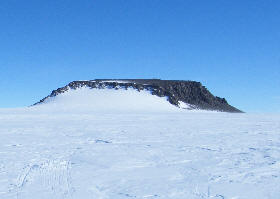
One of the Davis Nunataks, sunny day
ANSMET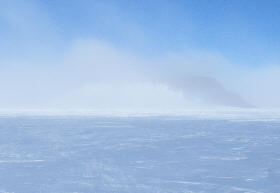
Same nunatak, foggy morning
ANSMET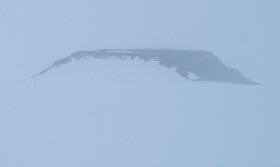
Same nunatak, snowy day
ANSMETOh, the Weather Outside Is Frightful...
December 29, 2008
It is unavoidable when doing field work that you are at the mercy of Mother Nature. Today she has been unkind to us.
On a clear day, the Davis Nunataks-Mount Ward area of the Dominion Range is quite scenic. And clear days, if the winds are not too strong, make for excellent meteorite hunting. We can spend all day out on the ice and readily separate meteorite from Earth rock based on just a cursory glance. On such days, we can "clear" vast expanses of ice. The first few days with the entire team present were like that.
Sometimes we get low-level fog, from the surface to maybe about 150 to 250 meters (500 to 800 feet) above the surface. We had such a day yesterday. We cannot work in the fog because of the poor lighting, but happily, the fog often burns off in the morning and we can get to work later in the day. That is what we did yesterday and managed to collect 31 meteorites.
The really nasty weather, however, comes out of the north. The air is warm and calm. You may think this seems ideal. Hah! Warm air from the north usually brings moisture, which in Antarctica means snow. This is bad for two reasons. One is that we really cannot see much of anything in the snow. It's as though all the meteorites (and Earth rocks, too) have hidden on us. Indeed, the very hills seem to disappear. But far worse is that if we get even an inch of snow, many of the meteorites will be buried. We will have no recourse but to wait until the katabatic winds resume, and blow all the new snow away. (Katabatic winds are strong cold winds out of the continental interior to the south.)
Today we are having a snow day, and the accumulation is beginning to get high enough to shut us down until the katabatic winds return. Sigh.
The inclement weather did not daunt Joe. About noon he went out and foot-searched in the moraine we were in last Friday. He managed to find a meteorite amongst all those Earth rocks, and in some of the poorest lighting conditions to boot!
100 years ago his date: Shackleton's team had a much different day than ours. They had strong katabatic winds and bitter cold, -12 to -17 F. In spite of this, the curse of soft snow, and suffering from altitude sickness, those hearty souls managed to man-haul their sledge 12 and a third miles.
Cheers,
LYAN
duck
Support our core enterprises
Your support powers our mission to explore worlds, find life, and defend Earth. You make all the difference when you make a gift. Give today!
Donate

 Explore Worlds
Explore Worlds Find Life
Find Life Defend Earth
Defend Earth


